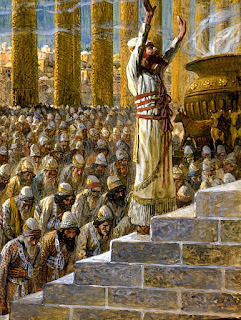The first particulars of a description of the Temple are given in the First Book of Kings: a few more are added in the Second Book of Kings and in Jeremiah. The parts wanting in these three books are given in Ezekiel, and nowhere else in the world.
It is as if the writer of the Kings, and Jeremiah and Ezekiel, had examined each what the other had written, and then each supplied what the others had omitted. Thus, in Kings, many inside measures of the house are given, but no outside ones; while in Ezekiel the outside measures are supplied, together with some inside measures which were omitted in Kings: and, when all the measures are put together, they perfectly agree, and make one house.
In general, it is a truth which will be established by a hundred examples, that parts which are fully described in Kings are only mentioned in Ezekiel, and those which are only mentioned in Kings are fully described in Ezekiel. Thus
it is barely mentioned in Kings that the Temple had courts, gates, altars, and little chambers; but no measures or descriptions are given of them: while in Ezekiel the courts, gates, and altars are minutely described, and the little chambers are shown to be watch-towers, three each side of each gate, PI. XIII. and XV.; and are fully described and measured, with the distances between the groups and between each other, Ezek. xl. 7-10. So, on the other hand, two pillars — Jachin and Boaz — are minutely described in 1 and 2 Kings and Jeremiah, together with the porch in which they stood.
The same porch is described in Ezekiel, with the bare mention of two pillars, one each side of it. But the length of this porch is given as twenty cubits in both places, bb', PI. VII.; while the width in Kings is ten cubits, but in Ezekiel it is eleven cubits, 1 Kings vi. 3; Ezek. xl. 49. But in Kings the measures are taken from the inside of the house, outwards: while in Ezekiel the measuring begins at the east gate of the outer court, at o, PI. XIII., and proceeds inwards, on the dotted line, to the house in the centre; thus from without inwards, and then into the house. Hence the width of ten cubits is an inside measure, gd', PI. VII.; and eleven cubits is an outside measure, gb'. Hence the porch had a wall one cubit thick, b'd'. That it had a wall is further evident in that it had a gate (Ezek. xl. 48), which was six cubits wide, cc' (same); and, if there were no wall, there would be no need of a gate.
Solomon Dedicates the Temple at Jerusalem, c. 1896-1902, by James Jacques Joseph Tissot (French, 1836-1902) or followers, gouache on board, 10 5/16 x 7 1/2 in. (26.2 x 19.2 cm), at the Jewish Museum, New York.
Date: c. 1896-1902
This Image (or other media file) is in the public domain because its copyright has expired. This applies to the United States, where Works published prior to 1978 were copyright protected for a maximum of 75 years. See Circular 1 "COPYRIGHT BASICS" PDF from the U.S. Copyright Office. Works published before 1923 in this case c. 1896-1902, are now in the public domain.
This file is also in the public domain in countries that figure copyright from the date of death of the artist (post mortem auctoris in this case James Jacques Joseph Tissot (1836-1902) and that most commonly runs for a period of 50 to 70 years from December 31 of that year. +sookie tex
James Joseph Jacques Tissot [Public domain], via Wikimedia Commons.
TEXT CREDIT: Solomon's temple: or, the tabernacle ... Volume 61 of Solomon's Temple: Or, the Tabernacle, Timothy Otis Paine. Author: Timothy Otis Paine. Publisher: Phinney, 1861. Original from: Harvard University. Digitized: Jan 24, 2008. Length: 99 pages. Subjects: History › General, History / General, Solomon's temple.

No comments:
Post a Comment